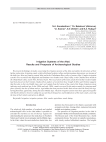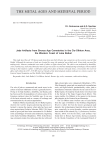Archaeology, Ethnology & Anthropology of Eurasia @journal-aeae-en
Статьи журнала - Archaeology, Ethnology & Anthropology of Eurasia
Все статьи: 524

Hunting equipment of Russians living near Tara on the Irtysh in the 17th and 18th centuries
Статья
This article describes Russian hunting tools unearthed from several sites near the town of Tara on the Irtysh: Ananyino I, Izyuk I, Tara, and Fort Bergamak. The functions of tools are assessed on the basis of archaeological parallels from the Baraba forest-steppe, ethnographic examples relating to the culture of the Irtysh natives, materials from Fort Albazin and Fort Sayansk, and much earlier burials dating to the Xianbei-Rouran time in the Altai Mountains. The variety of 17th–18th century hunting tools is best represented at Mangazeya, Fort Alazeya, and Fort Stadukhin. Apart from typological comparisons, technological analysis was carried out for several wooden and metal artifacts. Results are helpful for revealing continuities between the 17th–18th century Russian hunting tradition at Tara and that practiced in Old Rus and in the 15th–17th century Russian state, as well as for comparing it with the Siberian native traditions.
Бесплатно

Статья научная
This study focuses on the composition of the adhesives used to repair clay vessels, and on the technique of their preparation in the Late Neolithic and Chalcolithic (late 4th to early 3rd millennia BC) sites of Far Northeast Europe (the Republic of Komi and the Nenets Autonomous Okrug). Remains of adhesives were detected on 70 of 171 repaired pots. To date, five samples of ceramics from dwellings of the Chuzhyael culture have been analyzed. Gas chromatography-mass spectrometry revealed no markers of coniferous trees or bitumen; but did reveal markers of birch, suggesting that fractures and cracks on broken pots were plastered with birch tar. The composition of organic compounds in samples indicates the use of two vessels in the technological process: in one of them, birch bark was subjected to pyrolysis, while the other was a receptacle for tar. This comparatively complex technology reveals one more specialization in the domestic manufacture of the taiga hunter-gatherers, including the use of special furnaces. Analytic procedures employed by us open up new prospects for the study of the material culture of Far Northeast Europe, extend our knowledge of domestic manufacture, and offer new material for AMS dating.
Бесплатно

Iem cave: a stratified Late Pleistocene and Early Holocene site in Northern Vietnam
Статья научная
This study presents the fi ndings of excavations at Ɖiem Cave, a Late Paleolithic site in Vietnam. Several lithological units and cultural layers are identifi ed. Archaeological materials, including stone and bone artifacts, are described in detail. Findings from the three lower layers include sumatraliths, axes, bone tools, and ornaments. All of these, as well as features of the funerary rite, are typical of the Hoabinhian period. Human bones in the earliest burial were found in anatomical order, whereas those in other burials were crushed and charred. The authors demonstrate that the three lower layers date to the Pleistocene and belong to the Hoabinhian stage, whereas the upper layer dates to the Holocene and belongs to the Đa Bút culture. Micromorphological and stratigraphic observations suggest that the sedimentation of two of the Hoabinhian layers occurred under a humid climate, whereas one Hoabinhian layer attests to a more arid environment. Judging by the absolute dates, the Hoabinhian period appeared in Northern Vietnam before 23 ka BP. During certain stages of the Pleistocene, human populations in the region were rather numerous.
Бесплатно

Insight into ceramic technologies at the Maikop site of Ust-Dzheguta, Karachay-Cherkessia
Статья обзорная
Бесплатно

Integrative geophysical studies at the Novaya Kurya-1 cemetery in the Kulunda steppe
Статья
Бесплатно

Irrigation systems of the Altai: results and prospects of archaeological studies
Статья научная
We present the fi ndings of studies concerning the irrigation systems of the Altai and outline the directions of their further exploration. Irrigation canals, widely distributed in alpine valleys and intermontane depressions, are streams of the drift type. Most are found in central Altai and in the Chulyshman River valley of eastern Altai. Complex irrigation systems were recorded in the Bilgebash and Sarduma river mouths in the Chuya valley, in the Chulcha River mouth in the Chulyshman valley, and in Tötö, the Kurai basin. Pilot excavations of the main canals showed that wooden troughs had been placed on their bottoms. Radiocarbon analysis of wood from those troughs (Cheba and Oroktoi) suggests that they date to the Late Middle Ages, and a soil sample from the bottom of the canal of the Tenga irrigation system indicates early medieval age. In the 1800s and early 1900s, canals were used by the natives mainly for watering small plots of barley, but also of wheat and rye. Agriculture has been practiced in the Altai at least since the Early Iron Age, having fl ourished, apparently, during the Early Middle Ages. The fi rst irrigation systems must have appeared together with the fi rst farmers; however, taking into account the prolonged use and modifi cations of the main canals, assessing the time of their initial construction is diffi cult.
Бесплатно

Jade artifacts from Bronze Age cemeteries in the Cis-Olkhon area, the western coast of lake Baikal
Статья
Бесплатно

Kainar: a late 18th to early 20th century ritual and housing complex in the Northern Ustyurt
Статья
Бесплатно

Karakalpak family ritualism: the Bes Kiyim custom in the transformation of traditional culture
Статья обзорная
Бесплатно

Khengerekte-Sukhotino-an Upper Paleolithic culture in Transbaikalia
Статья научная
During the studies at the Barun-Alan-1 stratified site in Western Transbaikalia, a lithic industry was described, providing a basis for a new archaeological culture, termed Khengerekte. Similar materials were excavated from nearby sites such as Sloistaya Skala and Khenger-Tyn-3 Svyatilishche. A comparative analysis of the Khengerekte industry of Barun-Alan-1 and that from the Sukhotino-4 in southern Chita, Eastern Tranbaikalia, reveals that most of their typological groups are quite similar. On that basis, the culture’s distribution area was extended, and the culture itself was renamed Khengerekte-Sukhotino, spanning ~400 km from Barun-Alan-1 in the west to Unenker in the east. The calendar age of excavated layers of key Khengerekte-Sukhotino sites, Barun-Alan-1 and Sukhotino-4, was estimated at 12–33 ka BP. Their lithic industry, based mainly on microblades, is described. Bifaces, unifaces, and high side-scrapers are common. The origin of the Khengerekte-Sukhotino culture is an open question.
Бесплатно

Kinship analysis of human remains from the Sargat mounds, Baraba forest-steppe, Western Siberia
Статья
Бесплатно

Komudvany—a Final Paleolithic Site in the Lower Ob Valley: Geomorphology, Paleontology, Archaeology
Статья научная
This article is devoted to the preliminary results of multidisciplinary studies at Komudvany—a site located within a “mammoth cemetery” in the Lower Ob basin. We present the excavation history, geomorphological characteristics, results of radiocarbon analysis, and descriptions of archaeological and faunal remains. According to geological and geomorphological criteria, three parts of the site are distinguished: the terrace, the promontory, and the fl oodplain. The radiocarbon analyses of bones show the chronological heterogeneity of fl oodplain fi nds. Finds from the promontory and the terrace most likely represent a single episode of habitation and butchering or collecting bones and tusks. The mammoth “cemetery” was dated to 20–12 cal ka BP. At least one episode of habitation and human activities has been registered and dated to 15–14 cal ka BP. Archaeological fi nds and series of radiocarbon dates suggest the attribution of Komudvany to the Final Paleolithic. It is the northernmost site of that period in the West Siberian Plain and, along with Lugovskoye, is a reference object for studying the early human habitation in the northern regions of Asia.
Бесплатно

Lakhuti-IV: a new site of the Loessic Paleolithic in Tajikistan
Статья научная
We present the fi ndings of excavations at the Early Paleolithic site of Lakhuti-IV in the middle reaches of the Obi- Mazar River, Republic of Tajikistan. The geological and geomorphological situation in the area is reconstructed, and Pleistocene deposits are described. On the basis of the available chronostratigraphic constraints, we can determine time of formation of the cultural layer that is associated with deposits of the fi fth buried soil (pedocomplex 5, dated to ~0.5 Ma ago). Characteristics of archaeological fi nds (662 artifacts) from eight cultural horizons are discussed. Primary reduction is dominated by the simplest parallel, radial, and slice cores. Among fl akes, “citrus slices” and decortication chips are the most frequent. Tools include numerous fl akes and retouched fragments. Single-edged sidescrapers on large fl akes, denticulate-notched tools, and unifaces are abundant. The concentration of artifacts is very high for the Khovaling Loess Plateau. Lakhuti IV is the fi rst site of the Loessic Paleolithic where artifacts occur in distinct archaeological horizons. Industries associated with pedocomplexes 6–4 in the region (Obi-Mazar-VI, Lakhuti-I, -IV, etc.) show common features, such as primary reduction techniques (slice, radial, simple parallel) and the composition of the toolkits (choppers, unifaces, single-edged side-scrapers, etc.). The fi ndings allow us to draw more reliable parallels with contemporaneous industries of other regions. The closest similarities to industries of the Karatau culture are seen among the Soanian industries in northern Hindustan and the Early Paleolithic assemblages of southwestern China.
Бесплатно








